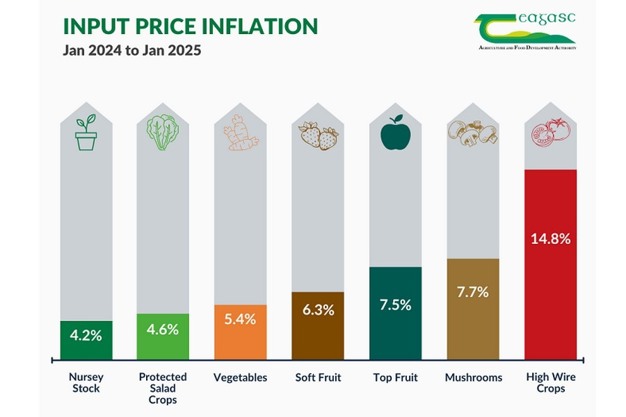The Horticulture Crop Input Prices 2025 Report, produced by the Teagasc Horticulture Development Department, has been published. The report shows that the trend of significant input price inflation in the horticultural sector since 2021 has continued for 2025.
The report, the fifth of its kind, indicates an average 51% increase in the cost of inputs for the horticulture sector over the last five years.
While input price inflation in the horticulture sector in Ireland has been significant in recent years, the impact of weather-related events in the 2024 growing season, followed by significant storm damage in January 2025, has also impacted the sector.
In 2025, labor which accounts for an average 42.6% of the input costs in horticulture has contributed to overall input price inflation in the sector. Investment from the sector to reduce the reliance on labor and the impacts of climate events will require a market response to ensure the economic and environmental sustainability of Irish horticultural production into the future.
 © Teagasc
© Teagasc
Acting Head of Teagasc Horticulture Development Department, Michael Gaffney said: "The publication of this report indicates significant input price inflation since 2021 in the horticultural sector.
"The ability to reinvest, combined with longer-term sourcing agreements can also contribute to encouraging generational renewal of businesses."
Other points to note
Investment from the horticultural sector to reduce reliance on labor and mitigate the impacts of climate events will require a market response to ensure the economic and environmental sustainability of Irish horticultural production in the future. Technologies aimed at reducing labor reliance are beginning to be trialed in some key horticultural sub-sectors. However, the financial cost of these technologies is significant, and their availability is likely to be limited in the short to medium term. Therefore, these investments will need adequate support to be successful.
The sourcing of labor continues to be a significant challenge for the sector. It is crucial to avoid a gap between the availability of labor and the availability of labor-saving technologies. Technologies exist that can extend the growing season of existing crops and enable diversification into new market opportunities. Growers need to be incentivized to invest in these systems to bring production closer to consumption, thereby reducing labor requirements, food waste, and packaging associated with long supply chains. Additionally, horticultural fresh produce has a comparatively low environmental footprint compared to other foods and offers significant health benefits for consumers.
Source: Teagasc
